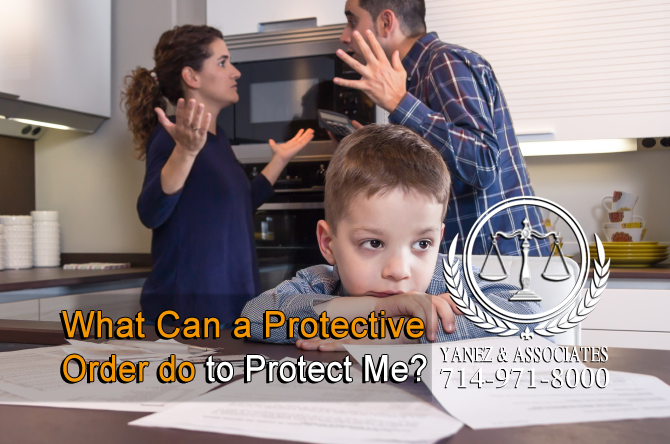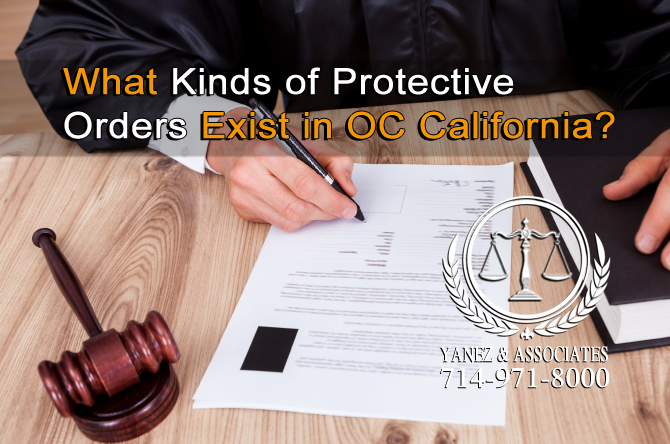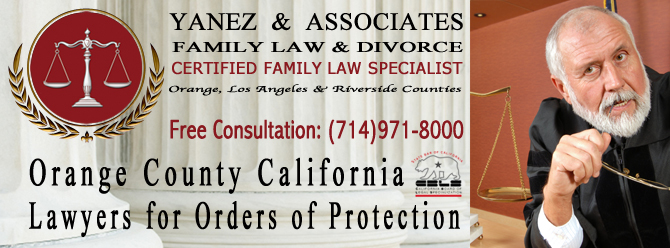FAQ: What Can a Protective Order do to Protect Me and my family in Orange County?
Orders of Protection in Orange County, California
If you or a loved one has suffered violence at the hands of another person, you should consider obtaining an order of protection, also known as a restraining order. Orders of protection can help protect you in several ways, including disallowing the restrained person from going near you or your loved ones.
The purpose of an order of protection is to allow you to get away from the person who is abusing you so that you can move forward with your life safely.
What Can a Protective Order do to Protect Me?
There are several ways that an order of protection can help protect victims of violence in California. Generally, a protective order, or restraining order, restricts the actions of the restrained person in order to allow the protected person, or protected persons, to continue living in a normal manner without the added worry of violence or abuse.
The restrained person is the person who has been accused or convicted of violence or abuse toward the protected person. The protected party in the restraining order may include the person who faced abuse as well as the protected person’s children or other loved ones.
Restraining orders restrict the restrained person in several ways.
• A protective order may restrict the actions that the restrained person can take, especially when those actions involve the protected parties.
• The restrained person may be restricted from contacting or communicating with the protected person in any way, including phone calls, text messages, email or other electronic communication, or mail or written communication.
• The restrained person may be restricted from contacting the protected party through attacking, battering, or assault.
• The restrained person may be restricted from contacting the protected party by stalking, harassing, or threatening the protected party.
• The restrained person may be restricted from sexually assaulting the protected party.
• The restrained person may be restricted from destroying the protected party’s property.
• The restrained person may be restricted from harming the protected party’s pet.
• The restrained person may be restricted from disturbing the peace of the protected party.
• A protective order may require the restrained person to stay a certain distance from specific people or places.
• The restrained person may be restricted from going near the protected person.
• The restrained person may be restricted from going near the protected person’s home or workplace.
• The restrained person may be restricted from going near the protected person’s children, including their places of school, work, childcare, or other places they frequent.
• The restrained person may be restricted from going near the protected person’s vehicle, or places that he or she frequents.
• A protective order may also require the restrained person to move out of his or her home. Usually, if a domestic violence order is required, the restrained person could be required to move out of his or her own home because the protected person also resides there.
• A protective order may also include other types of court orders, like child support, spousal support, child custody, visitation, and more. If these orders are included in your restraining order, it is important to follow these terms - even if they are a part of a temporary or emergency protective order. Failing to follow the terms of these orders may be reason for the judge to extend the orders.
What Kinds of Protective Orders Exist in OC California?
There are four main kinds of protective orders in California: a domestic violence restraining order, a civil harassment restraining order, a workplace violence restraining order, and an elder abuse or dependent adult abuse restraining order. Each is issued in a specific kind of situation.
Abuse, in all of these situations, can constitute various kinds of violence including physical abuse, mental abuse, verbal abuse, psychological abuse, child abuse, sexual abuse, etc. The types of restraining orders that can be issued depend, generally, on the relationship between the abuser and the abused person. This is because each type of restraining order is meant to provide protection for a different type of violent or abusive situation.
Domestic Violence Restraining Orders
Domestic violence restraining orders are appropriate in situations where the abuser and the abused person have a close relationship. This can include any of the following relationships.
• People who are married,
• People who are in a registered domestic partnership,
• People who are legally separated,
• People who are divorced,
• People who have had an annulment,
• People who are dating,
• People who used to date,
• Parents and children,
• People who share a child together,
• Grandparents and grandchildren,
• Siblings,
• Parents or children in-law,
• First-degree relationships in family.
Civil Harassment Restraining Orders
Civil harassment and domestic violence restraining orders are very similar. The main difference is that in civil harassment, the abuser and the abused person are not in a close relationship.
Civil harassment restraining orders may be appropriate if the two parties are related more distantly, like a neighbor, coworker, friend, aunt, uncle, cousin, niece, nephew, or another distant relationship.
Workplace Violence Restraining Orders
In the workplace, when harassment occurs, either a civil harassment restraining order or a workplace violence restraining order may be appropriate. Only an employer can ask for a workplace violence restraining order, and only to protect an employee who is facing abuse, violence, harassment, threats, etc. in the workplace.
Employees who are facing abuse at work can request a civil harassment restraining order to protect themselves. A workplace violence restraining order is meant to protect another person.
Elder Abuse or Dependent Adult Abuse Restraining Orders
When a person is either 65 years old or older, or at least 18 years old with a physical or mental disability that impairs the person’s ability to care for him or herself, an elder abuse or dependent adult abuse restraining order may be more appropriate.
Elders or dependent adults are often victims of different kinds of abuse, including financial abuse, physical abuse at the hands of a caregiver, neglect, abandonment, or deprivation.
Unfortunately, elders and dependent adults may face abuse at the hands of their own caregivers - so it is important to report abuse when you see it.
How Can I Get a Protective Order in California?
Depending on the kind of protective order that you need, there are various ways to obtain one. California law is designed to provide immediate protection for victims of abuse, so if you or a loved one is facing abuse, contact law enforcement and an attorney as soon as possible.
There are three main kinds of protective orders: emergency protective orders, temporary restraining orders, and permanent restraining orders.
An emergency protective order can be granted immediately with the help of any law enforcement officer. If you are facing abuse or violence right now, contact law enforcement as soon as possible. An emergency protective order is intended to last long enough for you to contact the courts and request a hearing and a temporary restraining order. It can protect you immediately, and help you to get away from your abuser.
A temporary restraining order can be granted within seven days. You should work with a restraining order attorney in California to fill out paperwork that can convince the judge that you need a temporary restraining order. If the judge grants your request, your temporary restraining order can last anywhere between 20 and 25 days, depending on how long it takes for a hearing to be held regarding your permanent restraining order.
A permanent restraining order can be granted only after a hearing has been held where both parties have the opportunity to share their stories. If a judge decides that your request for a restraining order should be granted, it will go into effect immediately. A permanent restraining order can last for up to three years, and if after three years you believe it is necessary to extend the order, you may request it at that time.
Because much of the judge’s decision depends on your word and the word of the other party, it is critical that you work with a qualified attorney so that you can build the best case possible. Your attorney can help you build a case that includes real evidence of abuse, violence, and the need for a restraining order.
Orange County Lawyers for Orders of Protection
If you or a loved one is facing domestic violence or abuse, especially if your loved one is a child, an elder person, or a dependent adult, it is your responsibility to take steps to protect yourself and your loved ones. If you are facing danger right now, contact the authorities immediately.
Your first step, once you have found safety, should be to contact an attorney. A domestic violence lawyer will know how to help you find safety right now, and how to obtain the right restraining order for you. Contact the lawyers at Yanez & Associates in Orange County, California, today to schedule your free initial consultation.
















